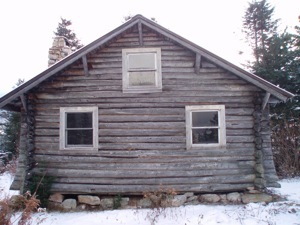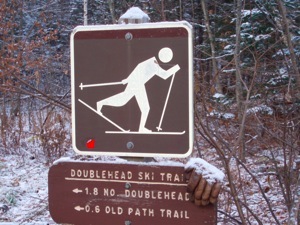November 17, 2009


By Marty Basch
Winter's approaching finger touched the mountains, leaving traces of snow on trees, downed leaves, ledges, evergreen branches and hiking boots marching through it all.
Some of the snow is likely to stay, especially that encountered on the north-facing side of the 3,000 foot mountain. But some of it was already gone by late morning at the base and its roughly 1,500 foot elevation.
Between the two were opportunities to stand high above the patchwork of Jackson with the ski trails of Black Mountain below and look across the valley to the robust Presidential Range cloaked by threatening dark clouds that did nothing but unload passing snow showers.
Double the fun
The Doubleheads in Jackson are part of a ridge of mountains south of the Carter-Moriah Range and southwest of Maine's Baldface-Royce Range. The two mountains provide exciting White Mountain vantage points for peaks hovering around 3,000 feet.
South Doublehead is the smaller of the two at 2,939 feet, but a ledge just shy of its summit provides wondrous views. North Doublehead at 3,053 feet. The rustic cabin with wood stove on the summit's east side with Presidential and Carter Range vistas was built in the 1930s by the Civilian Conservation Corp and is available year-round with reservations through www.recreation.gov.
North Doublehead is also home to the Doublehead Ski Trail which was also cut by the CCC and is a welcome wide trail for the descent until it is covered deeply in snow for skiers and snowboarders.
To connect all the aforementioned alpine dots, make a nearly 4-mile circuit along the ski trail, Old Path and New Path that begins on Jackson's Dundee Road just beyond Black Mountain.
Trekking
The trek began on the snow-dusted and gloriously benign ski trail which also had some muddy stretches where hiking boots can make the transition quickly from dry to mucky and wet.
The ski trail is also a CCC creation and was constructed in 1934 for the then growing skiing community in the North Conway area during the era of the snow trains which stopped nearby. The ski trail is a testament to the times with its fast fall lines and plunging turns. Instead of bend zee knees, as the Austrian ski instructors used to say to their students, it's easy on the knees of hikers.
After about a half mile, it's time to leave the ski trail for the much steeper Old Path and a steady climb. It's not easy, but there are lovely firs made even more charming by thin layers of snow upon them.
The sky appeared to be hidden until reaching the saddle between South and North Doublehead where a welcome blue burst out overhead. Turning right in the virgin white led rather quickly up to the forested South Doublehead. Shy of the summit was a spur path that led to an incredible overlook down to Black and out to the fire tower on Kearsarge North and imposing Carter Dome.
Col to cabin
Then it was time to retrace the same path and footprints down to the col and then up for a final steep stretch over snow-covered rocks to the North Doublehead summit where the cabin looked worn and the usually stunning view from out its front was muted by clouds.
But behind the cabin is another ledge vantage point looking to the east. Mountain Pond looked like a crescent and it was impossible to spot its waterside lean-to while beyond it lay the mountains of western Maine and a few lakes (like Kezar) and ponds.
The board-less descent with one ski pole was down the ski trail just outside the cabin. The wide trail was a welcome pleasure after the restricted and steep Old Path. Maybe 20 feet wide on average with a pitch of approximately 20 degrees there was ample room to turn even without skis or a snowboard. That was because slippery things — downed leaves and wet rocks — were hidden beneath the snow.
A few snow showers provided thick, wet snowy kisses during the descent alongside frozen brush on the blue-diamond marked trail. That mucky section was still there, and in no time wet hiking boots were drowning in mud. That was okay because the the heated truck was steps away and later the boots dried by a warming wood stove during November's annual transition to cold.





